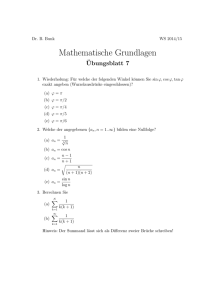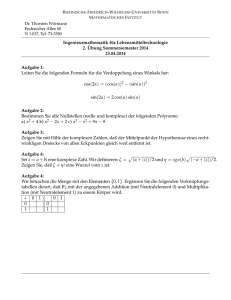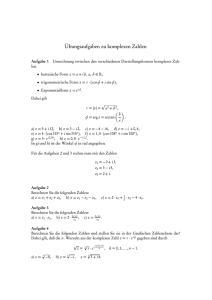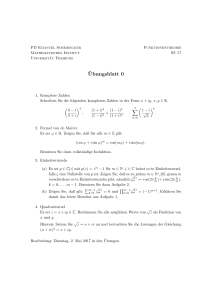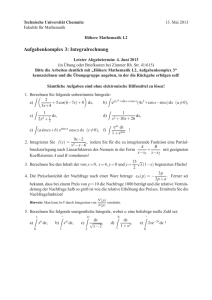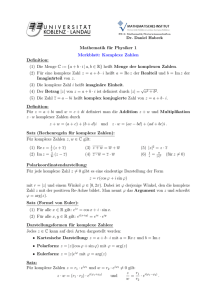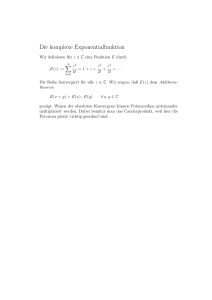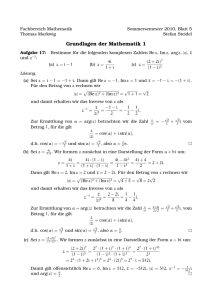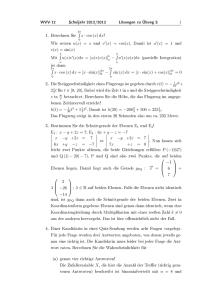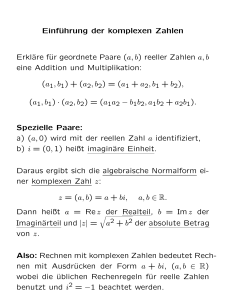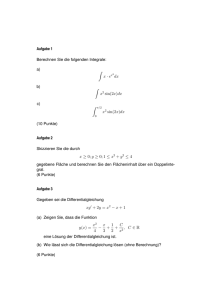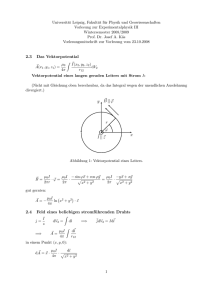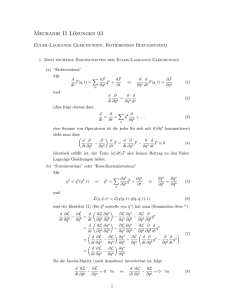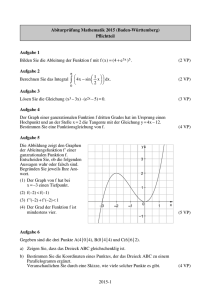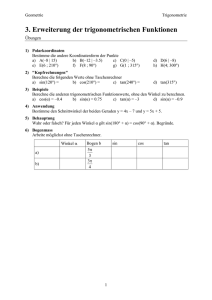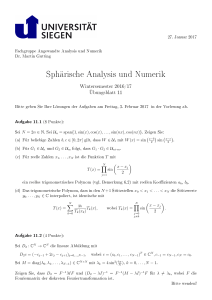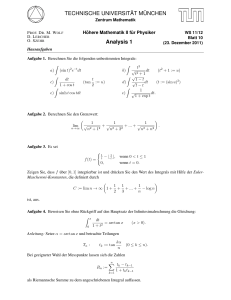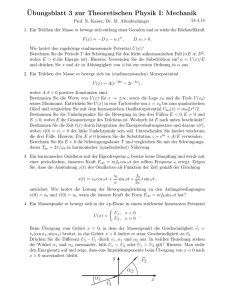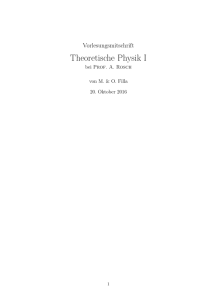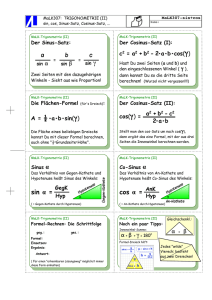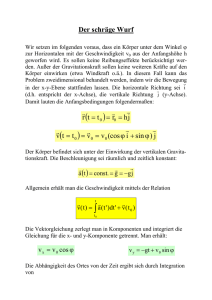Lineare Differenzengleichungen mit konstanten Koeffizienten
Werbung
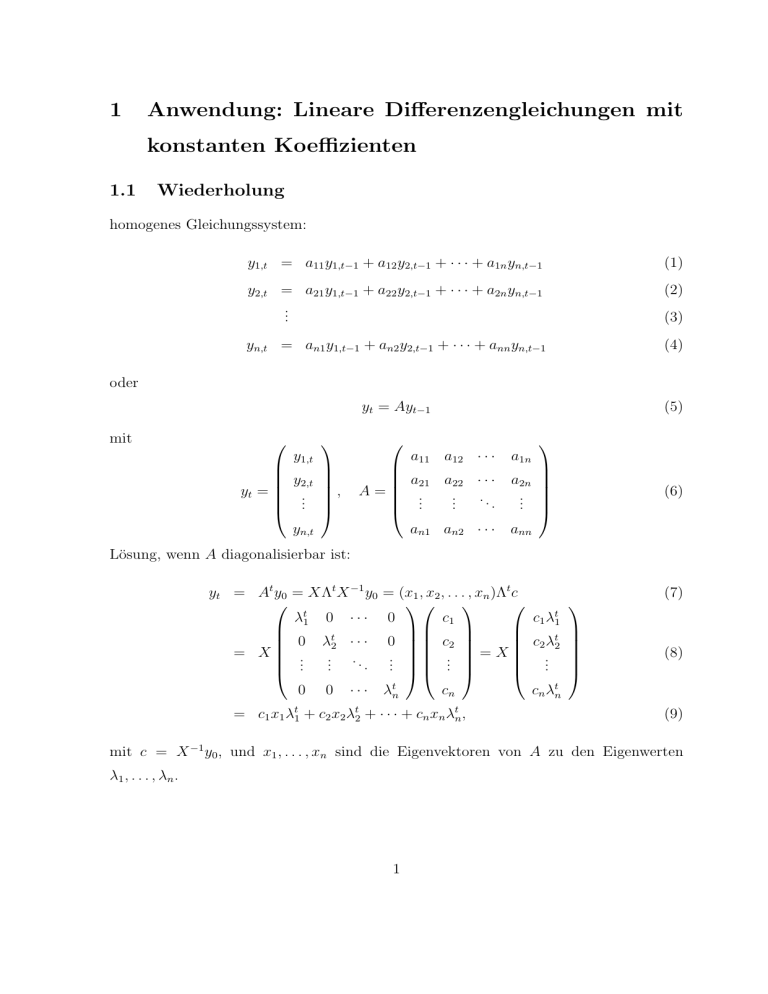
1
Anwendung: Lineare Differenzengleichungen mit
konstanten Koeffizienten
1.1
Wiederholung
homogenes Gleichungssystem:
y1,t = a11 y1,t−1 + a12 y2,t−1 + · · · + a1n yn,t−1
(1)
y2,t = a21 y1,t−1 + a22 y2,t−1 + · · · + a2n yn,t−1
..
.
(2)
yn,t = an1 y1,t−1 + an2 y2,t−1 + · · · + ann yn,t−1
(4)
yt = Ayt−1
(5)
(3)
oder
mit
yt =
y1,t
y2,t
..
.
,
A=
yn,t
a11 a12 · · ·
a1n
a21 a22 · · ·
..
..
..
.
.
.
a2n
..
.
an1 an2 · · ·
ann
(6)
Lösung, wenn A diagonalisierbar ist:
yt = At y0 = XΛt X −1 y0
λt 0 · · ·
1
0 λt · · ·
2
= X .
.
.. . . .
..
0 0 ···
= (x1 , x2 , . . . , xn )Λt c
0
c1
c1 λt1
c
c λt
0
2
2 2
. =X .
..
.
..
.
.
t
t
λn
cn
cn λn
= c1 x1 λt1 + c2 x2 λt2 + · · · + cn xn λtn ,
(7)
(8)
(9)
mit c = X −1 y0 , und x1 , . . . , xn sind die Eigenvektoren von A zu den Eigenwerten
λ1 , . . . , λ n .
1
1.2
Ein Beispiel mit komplexen Eigenwerten
Betrachte das System
y1t
=
y2t
1
2
1
2
1
2
− 12
y1,t−1
.
(10)
y2,t−1
Die Eigenwerte der Matrix A in (10) sind
√
√
1 ± 1 − 4 · 12
1 ± −1
1±i
1
1
λ1/2 =
=
=
= ±i .
2
2
2
2
2
(11)
Der Betrag der Eigenwerte ist
√( )
( )2
2
1
1
1
R = |λ1 | = |λ2 | =
+
= √ < 1,
2
2
2
(12)
also ist das System asymptotisch stabil. Um die Lösung explizit anzugeben, geht man
zur Polarkoordinatendarstellung der Eigenwerte über (siehe Anhang); es ergibt sich nach
(83)
(
θ = arccos
1/2
√
1/ 2
)
1
π
= arccos √ = ,
4
2
(13)
und somit
1 (
π
π)
π
π)
1 (
√
√
, λ2 =
.
cos + i sin
cos − i sin
λ1 =
4
4
4
4
2
2
Nach den Formeln von de Moivre (99) ist dann
(
(
)t (
)t (
1
1
π )
π )
π
π
t
t
λ1 = √
cos t + i sin t , λ1 = √
cos t − i sin t .
4
4
4
4
2
2
(14)
(15)
Eigenvektoren: Zu den Eigenwerten λ1 = (1 + i)/2 und λ2 = (1 − i)/2 sind die
Eigenvektoren z.B.
x1 =
X = (x1 , x2 ) =
1
1
i −i
,
1
i
und x2 =
1
−i
.
(16)
−1 −i −1 1 1 1/i
=
(17)
2i
2
−i 1
1 −1/i
2
1 1 i/i 1 1 −i
=
=
. (18)
2
2
1 −i/i2
1 i
X −1 =
2
Für die Potenzen von A ergibt sich
At = XΛt X −1
(
)t
1
1
√
=
2 2
(
)t
1
1
√
=
2 2
(
)t
1
1
√
=
2 2
1
1
i −i
cos
π
t
4
+ i sin
π
t
4
0
1 −i
cos π4 t − i sin π4 t
1 i
cos π4 t + i sin π4 t cos π4 t − i sin π4 t
1 −i
π
π
π
π
i cos 4 t − sin 4 t −i cos 4 t − sin 4 t
1 i
)t
(
π
π
π
π
cos 4 t sin 4 t
2 cos 4 t 2 sin 4 t
= √1
.
π
π
π
π
2
−2 sin 4 t 2 cos 4 t
− sin 4 t cos 4 t
0
Die Gleichung yt = Ayt−1 mit den Anfangswerten y0 = (y1,0 , y2,0 )′ hat dann die Lösung
(
)t
π
π
y cos 4 t + y2,0 sin 4 t
1
1,0
.
yt = At y0 = √
(19)
π
π
2
y2,0 cos 4 t − y1,0 sin 4 t
Für die Anfangswerte y0 = (y1,0 , y2,0 )′ = (0.1, 0.2)′ wird die Lösung in den Abbildungen 1 und 2 illustriert.
1.3
Inhomogenes System
yt = Ayt−1 + b
(20)
A sei diagonalisierbar. Ist I − A invertierbar (kein Eigenwert von A gleich 1), so ist der
Gleichgewichtspunkt (yt = yt−1 ) durch y = (I − A)−1 b gegeben. Die Lösung ist dann
3
0.15
y1t
y2t
0.1
y1t, y2t
0.05
0
−0.05
−0.1
0
2
4
6
8
10
12
14
16
18
20
t
Abbildung 1: Lösung von (10) mit y0 = (y1,0 , y2,0 ) = (0.1, 0.2)′ .
mit einem Startwert y0
y1 = Ay0 + b
y2 = Ay1 + b = A(Ay0 + b) + b = A2 y0 + (I + A)b
..
.
(21)
yt = At y0 + (I + A + A2 + · · · + At−1 )b
= At y0 + (I − At )(I − A)−1 b
= (I − A)−1 b + At (y0 − (I − A)−1 b)
= y + At (y0 − y)
= y + XΛt X −1 (y0 − y)
= y + c1 x1 λt1 + c2 x2 λt2 + · · · + cn xn λtn ,
4
(22)
0.06
(y1,1,y2,1)
0.04
0.02
y2,t
0
−0.02
−0.04
(y1,4,y2,4), usw.
−0.06
(y1,2,y2,2)
(y ,y )
1,3 2,3
−0.08
−0.04
−0.02
0
0.02
0.04
0.06
0.08
0.1
0.12
0.14
y1,t
Abbildung 2: Lösung von (10) mit y0 = (y1,0 , y2,0 ) = (0.1, 0.2)′ .
5
0.16
wobei Vektor (c1 , . . . , cn )′ sich aus dem Gleichungssystem X(c1 , . . . , cn )′ = (y0 − y)
ergibt. Die durch (22) gegebene allgemeine Lösung des Systems (20) ergibt sich also
als die Summe einer speziellen Lösung (y) plus die allgemeine Lösung des homogenen
Systems (“allgemeine Lösung” heißt hier, dass aus (22) durch entsprechende Wahl der
Konstanten c1 , . . . , cn eine Lösung für jeden Startwert generiert wird). Dies gilt auch
allgemeiner (z.B. für nichtkonstante Inhomogenitäten in (20)).
In (20) gilt wieder
lim yt = y = (I − A)−1 b für alle Startwerte y0
t→∞
(23)
genau dann, wenn alle Eigenwerte von A dem Betrage nach kleiner sind als 1 (dies auch
für nichtdiagonalisierbare A).
1.4
Differenzengleichungen höherer Ordnung
Gleichung n–ter Ordnung:
yt = a1 yt−1 + a2 yt−2 + · · · + an yt−n
(24)
mit Startwerten y0 , y1 , . . . , yn−1 .
Eine Möglichkeit besteht darin, die Gleichung höherer Ordnung in eine Gleichung
erster Ordnung zu überführen und mit Methoden des vorangegangenen Abschnitts zu
untersuchen. Z.B. für n = 2, setze
Yt =
Yt =
yt
,
A=
yt−1
yt
yt−1
a1 a2
1
dann ist
= AYt−1 =
,
a1 a2
1
(25)
0
0
yt−1
,
(26)
yt−2
d.h. yt = a1 yt−1 + a2 yt−2 und die Identität yt−1 = yt−1 . Die Gleichung (24) mit n = 2 ist
also asymptotisch stabil, wenn die Matrix A in (25) stabil ist (alle Eigenwerte |λi | < 1).
Charakteristische Gleichung der Koeffizientenmatrix:
A2 =
a1 a2
1
0
,
λ − a1 −a2 = λ2 − a1 λ − a2 .
|λI − A| = λ −1
6
(27)
Im allgemeinen Fall ist die Vektorform von (24) gegeben durch
Yt = AYt−1 ,
mit
yt
y
t−1
yt−2
..
.
yt−n+1
,
A=
a1 a2 a3 · · · an−1 an
1
0
0
···
0
0
..
.
1
..
.
0
..
.
···
···
0
..
.
0
0
0
···
1
Die charakteristische Gleichung der Matrix
a1 a2 a3 · · ·
1 0 0 ···
An =
0 1 0 ···
. . .
.. .. .. · · ·
0
0
(28)
0
···
0
0
.
..
.
0
(29)
an−1 an
0
0
..
.
1
0
0
..
.
0
(30)
ist
Dn := det(λI − An ) = λn − a1 λn−1 − a2 λn−2 − · · · − an−1 λ − an
n
∑
n
= λ −
ai λn−i = 0.
(31)
(32)
i=1
Die Identität ist klar für D1 . Via Induktion folgt dann durch Entwicklung von Dn nach
7
der letzten Spalte
Dn
= det
λ − a1 −a2 −a3 · · ·
−an−1 −an
−1
λ
0
···
0
0
0
..
.
−1
..
.
λ
..
.
···
0
..
.
0
..
.
0
0
0
···
−1
λ
···
n+1
= λDn−1 + (−1) (−an ) det
−1
λ
0
−1
0
..
.
0
..
.
0
0
0
···
λ
···
(33)
0
0
−1 · · · 0
.. . .
..
. .
.
0 · · · −1
= λDn−1 + (−1)n+1 (−an )(−1)n−1
(
)
n−1
∑
= λ λn−1 −
λn−1−i ai − an
(34)
(35)
(36)
i=1
= λ −
n
n
∑
λn−i ai .
(37)
i=1
Sind alle Nullstellen der Gleichung (31) verschieden, so ist die Lösung von (24)
gegeben durch
yt = c1 λt1 + c2 λt2 + · · · + cn λtn ,
(38)
wobei die ci s aus den n Anfangswerten y0 , y1 , . . . , yn−1 folgen, d.h. den Gleichungen (38)
für t = 0, 1, . . . , n − 1 mit vorgegebener linker Seite,
1
1
···
y0
y λ
λ2 · · ·
1 1
y 2 = λ2
λ22 · · ·
1
. .
..
.. ..
.
···
yn−1
λn−1
λn−1
···
1
2
d.h. als Lösung des Systems
c1
1
λn c2
c3 .
(39)
λ2n
.
..
.
.
.
λnn−1
cn
Sind alle Nullstellen λ1 , λ2 , . . . , λn verschieden, so hat dieses System eine eindeutige
Lösung, denn die Vandermondesche Determinante Vn (also die Determinante der Koef-
8
fizientenmatrix dieses linearen Gleichungssystems) ist
1
···
1 1
λ
λ
·
·
·
λ
2
n 1
∏
Vn := λ21
(λj − λi ).
λ22 · · · λ2n =
.
..
.. i<j≤n
..
.
···
. n−1 n−1
λ1
λ2
· · · λnn−1 Zum Beispiel für n = 2
und für n = 3
1 1
V2 = λ1 λ2
= λ2 − λ1 ,
1 1 1 V3 = λ1 λ2 λ3 = (λ3 − λ2 )(λ3 − λ1 )(λ2 − λ1 ).
2 2 2 λ1 λ2 λ3 (40)
(41)
(42)
Der allgemeine Fall folgt dann mittels Induktion: Entwicklung nach der letzten Spalte
von Vn zeigt, dass Vn als Polynom (n − 1)–ten Grades in λn aufgefasst werden kann:
Vn = an−1 λn−1
+ an−2 λn−2
+ · · · + a1 λn + a0 .
n
n
(43)
Aufgrund der Eigenschaften der Determinante hat dieses Polynom genau die Nullstellen
λ1 , λ2 , . . . , λn−1 , denn falls λn einen von diesen Werten annimmt, hat die Determinante
zwei identische Spalten und es gilt Vn = 0. Also ist
Vn = an−1
n−1
∏
(λn − λi ).
(44)
i=1
Der Koeffizient an−1 von λn−1
in (43) ergibt sich aber durch Streichung der letzten Zeile
n
und Spalte in Vn und ist daher aufgrund der Induktionsvoraussetzung
1
···
1 1
λ
λ2 · · · λn−1 1
∏
(λj − λi ).
an−1 = λ21
λ22 · · · λ2n−1 = Vn−1 =
.
.
.
i<j≤n−1
..
.. ..
···
n−2 n−2
n−2
λ1
λ2
· · · λn−1 9
(45)
Also ist insgesamt
Vn = An−1
n−1
∏
∏
i=1
i<j≤n−1
(λn − λi ) =
(λj − λi )
n−1
∏
∏
i=1
i<j≤n
(λn − λi ) =
(λj − λi ).
(46)
Beispiele:
1. Für die Gleichung yt = 1, 4yt−1 − 0, 48yt−2 mit den Anfangswerten y0 = 1 und
y1 = 0, 95 ist die Lösung
yt = 1, 75 · (0, 8)t − 0, 75 · (0, 6)t .
(47)
Siehe Abbildung 3.
2. Für die Gleichung yt = yt−1 − 0, 89yt−2 mit den Anfangswerten y0 = 1 und y1 =
0, 53 ist die Lösung
√
yt = ( 0, 89)t [cos(1, 0122 · t) + 0, 0375 sin(1, 0122 · t)].
(48)
Siehe Abbildung 4. In diesem Beispiel konvergiert yt etwas langsamer gegen den
Gleichgewichtswert y = 0 als im vorangegangenen Beispiel, d.h. die zum Startzeitpunkt bestehenden Abweichungen vom Ruhepunkt klingen langsamer ab, da
√
t
0.89 = 0.9434t schneller gegen 0 konvergiert als 0.8t .
Die Schwingungskomponente in (48),
c1 cos(θt) + c2 sin(θt),
(49)
kann auch in einer leicht modifizierten Form angegeben werden, die einfacher zu
interpretieren ist: Es ist
c1 cos(θt) + c2 sin(θt)
= Re{(c1 − ic2 )(cos(θt) + i sin(θt))}
= A · Re{(cos φ − i sin φ)(cos(θt) + i sin(θt))}
= A[cos φ cos(θt) + sin φ sin(θt)]
(89)
= A cos(θt − φ),
10
(50)
1
0.9
0.8
0.7
y
t
0.6
0.5
0.4
0.3
0.2
0.1
0
0
5
10
15
20
25
30
35
t
Abbildung 3: Lösung von yt = 1, 4yt−1 − 0, 48yt−2 mit y0 = 1 und y1 = 0, 95.
mit A = |c1 − ic2 | =
√
c21 + c22 und φ = arccos(c1 /A) (wenn c2 > 0) bzw.
φ = − arccos(c1 /A) (wenn c2 < 0). Dem Ausdruck (50) ist zu entnehmen, dass
es sich um eine Schwingung mit Amplitude (maximaler Ausschlag) A, Periode
2π
θ
√
und Phasenverschiebungswinkel φ handelt. Im obigen Beispiel ist z.B. A =
1 + 0.03752 = 1.0007 und φ = − arccos(1/A) = −0.0375, so dass die Lösung
(48) auch als
√
yt = 1.0007( 0, 89)t cos(1, 0122 · t + 0.0375)
geschrieben werden kann.
11
(51)
0.8
0.6
0.4
0.2
y
t
0
−0.2
−0.4
−0.6
−0.8
−1
0
10
20
30
40
50
60
70
80
t
Abbildung 4: Lösung von yt = yt−1 − 0, 89yt−2 mit y0 = 1 und y1 = 0, 53.
2
Anhang: Polynome und komplexe Zahlen
• Eine Funktion der Gestalt
f (x) = an xn + an−1 xn−1 + · · · + a1 x + a0
(52)
mit reellen Koeffizienten a0 , a1 , . . . , an und an ̸= 0 heißt reelles Polynom n-ten
Grades. an ist der Leitkoeffizient. Sind alle ak = 0, k = 0, . . . , n, so ist f das
Nullpolynom.
• Eine Zahl α ist eine Nullstelle von f , wenn f (α) = 0.
• Für n = 2, also quadratische Funktione, kann man die Nullstellen mit Hilfe der
12
pq–Formel in geschlossener Form angeben (sei der Einfachheit halber an = a2 = 1):
x2 + px + q = 0
( p )2
( p )2
x2 + px +
+q−
= 0
2
2
(
( p )2
p )2
x+
=
−q
2
2
√( )
p
p 2
− q.
x = − ±
2
2
(53)
• Die Nullstellen des quadratischen Polynoms (53) sind aber nur reell, wenn p2 > 4q.
• Für die quadratische Gleichung x2 + x + 4 = 0 z.B. ergibt die pq–Formel die
Lösungen
x1/2
1
=− ±
2
√
√
√
1
−1 ± 1 − 16
−1 ± −15
−4=
=
,
4
2
2
(54)
d.h., die Gleichung hat keine reellen Lösungen.
• Man führt daher die imaginäre Einheit i mit i2 = −1 (i =
√
−1) ein.
• Es gilt
i2 = −1,
i3 = i · i2 = −i,
i5 = i4 · i = i,
i4 = (i2 )2 = (−1)2 = 1
i6 = i2 = −1, . . .
• Dann hat die obige quadratische Gleichung die komplexen Lösungen
√
√
√ √
1
−15
1
−1 15
1
15
− ±
=− ±
=− ±i
.
2
2
2
2
2
2
(55)
(56)
(57)
• Eine komplexe Zahl ist allgemein von der Form z = x + iy mit x, y ∈ R. Die reellen
Zahlen x und y heißen Real– und Imaginärteil von z, und werden mit Re z und
Im z bezeichnet.
• z heißt rein imaginär, wenn z = iy, y ∈ R.
• Den Körper der komplexen Zahlen bezeichnen wir mit C.
13
• Algebraische Operationen sind unter Berücksichtigung der Regel i2 = −1 dann
wie gewohnt definiert. Sei z = x + iy und w = u + iv.
– Addition:
z + w = (x + u) + i(y + v),
(58)
d.h., x + u und y + v sind Real– und Imaginärteil der Zahl z + w.
– Multiplikation:
z · w = (x + iy)(u + iv) = xu + i2 yv + i(uy + xv)
= xu − yv + i(uy + xv).
(59)
(60)
– Division:
z
x + iy
(x + iy)(u − iv)
=
=
w
u + iv
(u + iv)(u − iv)
xu + vy + i(uy − xv)
=
u2 + v 2
uy − xv
xu + vy
+
i
.
=
u2 + v 2
u2 + v 2
(61)
(62)
(63)
• Konjugation: Für z = x + iy ist z = x − iy die zu z konjugiert komplexe Zahl. Die
Lösungen obiger quadratischer Gleichung bilden also ein paar konjugiert komplexer
Zahlen.
• Es gilt:
z+w = z+w
(64)
z·w = z·w
(65)
z = z genau dann, wenn z ∈ R
z · z = x2 + y 2
(66)
(67)
• Der Betrag der kompexen Zahl z ist
|z| = |x + iy| =
14
√
z·z =
√
x2 + y 2 .
(68)
• Der Betrag ist also eine reelle Zahl. Wie für reelle Zahlen gilt für zwei komplexe
Zahlen z und w,
|zw| = |z||w|,
|z + w| ≤ |z| + |w|.
(69)
• Beispiele: Stellen Sie die folgenden komplexen Zahlen in der Form x + iy dar:
(a)
1
1−i
1−i
1
1
=
=
= −i
1+i
(1 + i)(1 − i)
2
2
2
(70)
3 + 4i
(3 + 4i)(2 + i)
6 + 4i2 + i(3 + 8)
2
11
=
=
= +i
2−i
(2 + i)(2 − i)
5
5
5
(71)
(b)
(c)
1+i
(1 + i)2
2i + 1 + i2
=
=
= i.
(72)
1−i
(1 − i)(1 + i)
2
√
√
(d) i: Der Ansatz i = a + ib führt auf i = (a + ib)2 = a2 − b2 + 2iab, woraus
a2 − b2 = 0 und 2ab = 1 folgt, also a = b = ± √12 . Also
√
1
i = ± √ (1 + i).
2
(73)
• Wir kommen zurück zu den Nullstellen von Polynomen.
• Ist z1 eine (reelle oder komplexe) Nullstelle von f , d.h., es gilt f (z1 ) = 0, so lässt
sich der Faktor z − z1 abspalten, d.h.,
f (z) = (z − z1 )q(z),
(74)
wobei q ein Polynom vom Grade n − 1 = Grad f − 1 ist.
• Nach dem Fundamentalsatz der Algebra hat jedes Polynom n–ten Grades genau n
(im allgemeinen komplexe) Nullstellen (Vielfachheiten eingerechnet). Wir können
also n–mal einen Linearfaktor abspalten,
f (z) = an (z − z1 )k1 (z − z2 )k2 · · · (z − zs )ks ,
(75)
wenn Polynom f die s verschiedenen Nullstellen z1 , z2 , . . . , zs jeweils mit den Viel∑
fachheiten k1 , k2 , . . . , ks hat, mit k1 + k2 + · · · + ks = si=1 ki = n. (zi ist eine
ki –fache Nullstelle von f .)
15
• Beispiel: Das Polynom
f (z) = 3z 3 − 3z 2 − 15z − 9 = 3(z − 3)(z + 1)2
(76)
hat die 2–fache Nullstelle −1 und die einfache Nullstelle 3.
An der quadratischen Gleichubg z 2 + pz + q = 0 mit den Lösungen
√
p2 − 4q
p
z1/2 = − ±
2
2
(77)
ist zu erkennen, dass komplexe Nullstellen immer in konjugiert komplexen Paaren
auftreten. Das ist auch allgemein der Fall; d.h. ist z1 = x + iy eine Nullstelle des
reellen Polynoms
P (z) = an z n + an−1 z n−1 + · · · + a1 z + a0 ,
(78)
so ist auch z 1 = x − iy eine Nullstelle, denn
0 = P (z1 )
=
an z1n + an−1 z1n−1 + · · · + a1 z1 + a0
(79)
(64)
=
an z1n + an−1 z1n−1 + · · · + a1 z1 + a0
(80)
(65)
an z n1 + an−1 z n−1
+ · · · + a1 z 1 + a0
1
(81)
(66)
an z n1 + an−1 z n−1
+ · · · + a1 z 1 + a0 = P (z 1 ),
1
(82)
=
=
wobei in der letzten Gleichung (66) gemeinsam mit ai ∈ R für i = 0, . . . , n verwendet wurde.
2.1
2.1.1
Polarkoordinaten komplexer Zahlen
Trigonometrische Funktionen
Ein Punkt P auf dem Einheitskreis ist durch Angabe der Länge θ des Bogens
vom Punkt (1, 0) zu P auf dem Kreis eindeutig bestimmt (Bogenmaß). Jedem
Winkel entspricht ein Punkt auf dem Einheitskreis, und wir definieren sin θ als
die Ordinate und cos θ als die Abzisse dieses Punktes (vgl. Abbildung 5). Da der
Umfang des Einheitskreises gleich 2π ist, ist die Länge des Bogens von (1, 0) zu
16
1.5
(0,1)
1
(a,b) = P
c=1
0.5
b
θ
(−1,0)
0
a
(1,0)
−0.5
−1
(0,−1)
−1.5
−1.5
−1
−0.5
Abbildung 5: sin θ =
0
0.5
b
c
= b, cos θ =
1
a
c
1.5
= a.
(0, 1), (−1, 0), (0, −1) und (1, 0) gleich π2 , π, 32 π und 2π, also z.B. sin(π/2) = 1,
sin(π) = 0, sin(3π/2) = −1, sin(2π) = 0, cos(π/2) = 0, cos(π) = −1, cos(3π/2) =
0, cos(2π) = 1. Offenbar ist sin π4 = cos π4 , und wegen sin2 θ + cos2 θ = 1 (a2 + b2 =
c2 = 1 in Abbildung 5) ist
sin
π
π
1
= cos = √ ≈ 0.7071.
4
4
2
17
(83)
sinus und cosinus
1
sin
cos
0.8
0.6
sin(x), cos(x)
0.4
0.2
0
−0.2
−0.4
−0.6
−0.8
−1
−2pi
−pi
0
pi/2
pi 3pi/2 2pi
3pi
4pi
x
Abbildung 6: sin und cos.
Bogenmaßwerte größer 2π (mehrfaches Umlaufen) und negative Werte (Umlaufen
in umgekehrter Richtung) sind sinnvoll, und daher kann man Funktionen
sin : R → [−1, 1]
(84)
cos : R → [−1, 1]
(85)
definieren, mit der Periode 2π, d.h. sin(x + 2kπ) = sin x und cos(x + 2kπ) = cos x
für k ∈ Z.
Es ist
cos(x) = cos(−x),
sin(x) = − sin(−x).
18
(86)
Additionstheoreme:
sin(x + y) = sin(x) cos(y) + sin(y) cos(x)
(87)
sin(x − y) = sin(x) cos(y) − sin(y) cos(x)
(88)
cos(x + y) = cos(x) cos(y) − sin(x) sin(y)
(89)
cos(x − y) = cos(x) cos(y) + sin(x) sin(y)
(90)
Aus (87) und (89) folgen z.B.
sin(2x) = 2 sin(x) cos(x)
(91)
cos(2x) = cos2 (x) − sin2 (x).
(92)
Umkehrfunktionen
Die Funktion cos : [0, π] → [−1, 1] ist streng monoton. Die Umkehrfunktion ist
arccos : [−1, 1] → [0, π],
(93)
siehe Abbildung 7.
2.1.2
Polarkoordinaten komplexer Zahlen:
Jede komplexe Zahl z ̸= 0 hat eine Darstellung
z = x + iy = R(cos θ + i sin θ)
mit
R = |z| =
√
x2 + y 2 ,
θ ∈ [−π, π].
(94)
(95)
Das Paar (R, θ) heißt Polarkoordinaten für z.
Diese Darstellung kann wie folgt konstruiert werden: Sei z = x + iy und (zunächst)
y ≥ 0. Setzt man
z
x
y
=
+i
=: ξ + iη,
|z|
|z|
|z|
(96)
θ = arccos ξ
(97)
so ist ξ 2 + η 2 = 1. Mit
19
arccos
pi
pi/2
−1
0
1
Abbildung 7: Die Umkehrfunktion des Cosinus.
ist dann θ ∈ [0, π] (vgl. Abbildung 7), cos θ = ξ, sin θ ≥ 0 und wegen ξ 2 + η 2 = 1 und
η ≥ 0 ist auch sin θ = η, also ξ + iη = cos θ + i sin θ.
Ist y < 0, so wählt man θ = − arccos ξ und wegen (86) ist dann ξ +iη = cos θ+i sin θ.
(Alternativ setzt man wie zuvor θ = arccos ξ und ξ + iη = cos θ − i sin θ.)
Zur Veranschaulichung kann die komplexe Zahlenebene verwendet werden (vgl. Abbildung 8). Die komplexe Zahl z = x + iy wird durch den Punkt (x, y) dargestellt.
Reellen Zahlen entsprechen die Punkte auf der x–Achse (reelle Achse), rein imaginären
√
Zahlen entsprechen jene auf der y–Achse (imaginäre Achse). |z| = R = x2 + y 2 ist der
Abstand des Punktes z = (x, y) vom Punkt (0,0).
Beispiele:
√
√
√
1. z = 1 + i 3: R = 1 + 3 = 2, θ = arccos(1/2) = π/3, also 1 + i 3 = 2(cos(π/3) +
i sin(π/3)).
2. z =
3
2
+
√
i323:
R=
√( )
3 2
2
+
9·3
4
(
= 3, θ = arccos
20
3/2
3
)
= arccos(1/2) = π/3, also
Im(z)=y
p
R = x2 + y 2
(x,y) = z = x+iy
iy
θ
x
Re(z)=x
Abbildung 8: Die komplexe Zahlenebene. Die komplexe
√ Zahl z = x + iy wird durch
den Punkt (x, y) dargestellt. Der Betrag |z| ist R = x2 + y 2 . Es ist sin θ = y/R und
cos θ = x/R, also z = x + iy = R(cos θ + i sin θ).
3
2
√
(
)
+ i 3 2 3 = 3 cos π3 + i sin π3 .
( √ )
(√ )
√
√
3. z = 4( 3 + i): R = 16 · 3 + 16 = 8, θ = arccos 4 8 3 = arccos 23 = π6 , also
√
( )
( )
4( 3 + i) = 8(cos π6 + i sin π6 ).
21
Formeln von de Moivre
Aus (91) und (92) folgt für z = x + iy = R(cos θ + i sin θ)
z 2 = R2 (cos θ + i sin θ)2 = R2 (cos2 θ + i2 sin2 θ + 2i sin θ cos θ)
(98)
= R2 (cos2 θ − sin2 θ + 2i sin θ cos θ)
= R2 (cos(2θ) + i sin(2θ)).
Allgemein ist für jede komplexe Zahl z
z n = (x + iy)n = Rn (cos(nθ) + i sin(nθ)).
(99)
Gleichung (99) kann aus (98) via Induktion hergeleitet werden, denn wenn (99) für z n−1
gilt, dann ist
zn
=
Rn (cos θ + i sin θ)n = Rn (cos θ + i sin θ)n−1 (cos θ + i sin θ)
=
Rn (cos((n − 1)θ) + i sin((n − 1)θ))(cos θ + i sin θ)
=
Rn {cos((n − 1)θ) cos θ − sin((n − 1)θ) sin θ
+i[sin((n − 1)θ) cos θ + cos((n − 1)θ) sin θ]}
(87)&(89)
=
Rn (cos(nθ) + i sin(nθ)).
22
